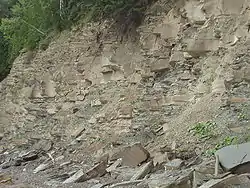Miguasha National Park
Miguasha Provincial Park (French: Parc national de Miguasha) is a protected area near Carleton-sur-Mer on the Gaspé Peninsula of Quebec in Canada. Created in 1985 by the Government of Quebec, Miguasha was designated a World Heritage Site in 1999 in recognition of its wealth of fossils, which display a crucial time during the evolution of life on Earth. Other names for this site are the Miguasha Fossil Site, the Bay of Escuminac Fossil Site, the Upper Devonian Escuminac Formation, and the Hugh-Miller Cliffs. It is also sometimes referred to on fossil specimens as 'Scaumenac Bay' or 'Scaumenac Bay P.Q.'
| Parc provincial de Miguasha | |
|---|---|
 Cliff of the Miguasha National Park | |
  | |
| Location | Nouvelle, Avignon Regional County Municipality, Quebec, Canada |
| Nearest city | Dalhousie, New Brunswick |
| Coordinates | 48°06′38″N 66°22′10″W |
| Area | 87,3 ha |
| Established | 6 February 1985 |
| Governing body | SEPAQ |
| Type | Natural |
| Criteria | viii |
| Designated | 1999 (23rd session) |
| Reference no. | 686rev |
| Region | Europe and North America |
Miguasha Natural History Museum


The park's museum features exhibits about the fossils and paleontology of the park. The museum's collection includes over 9,000 specimens of fossil fish and plants.[1]
Geology
The coastal cliffs are Upper Devonian strata of grey sedimentary rock belonging to the Escuminac Formation. They are composed of alternating layers of sandstone and shale, which are 350–375 million years old. The area today supports mainly birch, aspen, and fir forests.
Palaeontological significance
Some of the fish, fauna, and spore fossils found at Miguasha are rare and ancient species. For example, Spermasporites is thought to be one of the oldest flowering plant[2] genera on Earth.[3]
History
See also
- List of fossil sites (with link directory)
References
- "Miguasha National Park and Natural History Museum (Sépaq) | Gaspesian Heritage WebMagazine".
- As per reference, but possibly they meant 'seed plant'.
- UNESCO citation 686